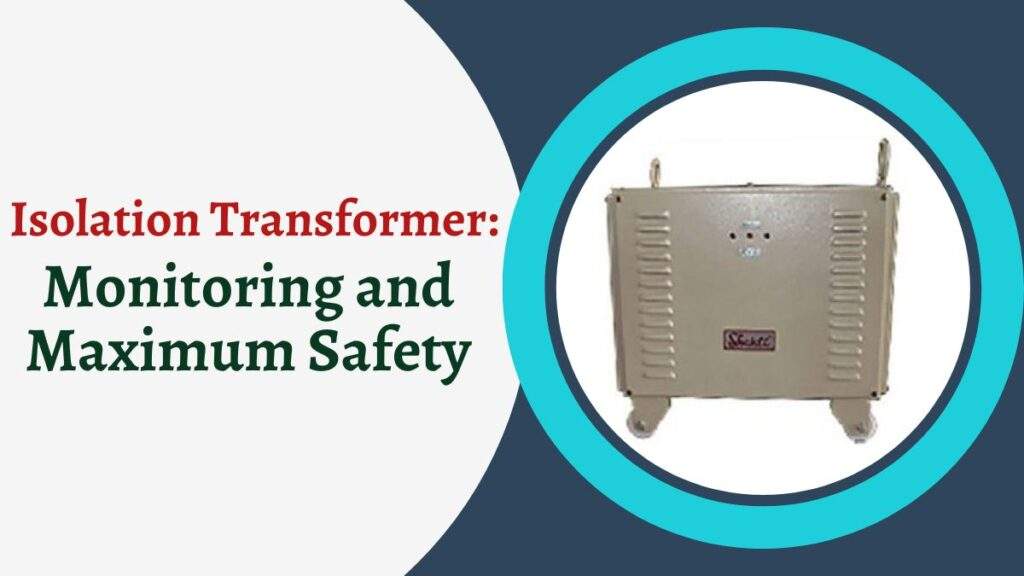
In today’s technologically advanced world, electrical power plays a vital role in every aspect of our lives. However, power quality issues and electrical disturbances can pose significant risks to sensitive electronic equipment and human safety. To mitigate these risks and ensure maximum safety, isolation transformers have become increasingly important.
The isolation transformer is an important element for the power quality of a low-voltage electrical system. Installing an isolation transformer upstream of your network makes it possible to galvanically isolate. Everything connected downstream of the transformer from everything upstream. And, consequently, protect it from disturbances coming from the distribution network, in particular transient over voltages and conducted disturbances. Isolation transformers are used to isolate two different parts of a circuit from each other while maintaining electrical continuity. This can help to prevent electrical shock, reduce electrical noise, and provide surge protection.
What is an isolation transformer?
Isolation transformers are widely used to prevent electrical shock, reduce electrical noise, and provide surge protection. The function of an isolating transformer is to separate the voltage circuit of electrical equipment from the mains through the use of separate power windings isolated from each other. The use of isolation transformers in India allows you to maximize electrical safety and protect electrical equipment.
Connecting an isolating transformer
The generally accepted home wiring scheme, implemented in accordance with current requirements, provides for the presence, along with phase and neutral, of a ground wire.
Consumers connected to such a network are grounded so that in the event of an emergency current leakage, the residual current device (RCD) mounted on the switchboard cuts off the power supply.
However, not every electrical appliance is provided with grounding. In such cases, the best solution to the problem of their safe operation is the installation of an isolating transformer, in the secondary winding of which an autonomous and reliably isolated electrical circuit appears.
In this circuit, a potential difference exists between the contacts of the transformer. And in the event of a breakdown in the insulation of the electrical appliance or the network itself. The electrical potential will again be present on the faulty device. However, it does not pose any danger to humans since, due to the lack of connection between the connection and the ground potential, the current flow circuit is cut off.
To avoid this, the following safety precautions must be strictly followed:
- The primary winding connected to the mains must be equipped with an RCD;
- Do not allow grounding of the housing of electrical appliances connected to the network through an isolating transformer;
- Connect the isolation transformer to only one electrical appliance. If it is necessary to connect several devices, it is mandatory to use voltage control equipment.
Monitoring an Isolation Transformer
Monitoring the performance of an isolation transformer with a 3-Phase Linear Stabilizer is vital to ensure its optimal functionality and safety.
Key parameters to monitor include:
Voltage: The voltage should be monitored to ensure that it is within the appropriate range. If the voltage is too high or too low, it can cause problems in the circuit.
Temperature: The temperature of the transformer should be monitored to ensure that it is not overheating. If the transformer gets too hot, it can cause damage to the insulation and other components.
Humidity: Humidity should be monitored to ensure that the transformer is not affected by moisture. Moisture can cause corrosion and other damage to the transformer.
Insulation resistance: The insulation resistance should be monitored to ensure that the dielectric barrier is functioning properly. If the insulation resistance is too low, it can cause electrical continuity between the two circuits.
Efficiency and applications of an isolating transformer
During the operation of any transformer, the loss of a certain part of the energy is inevitable. For isolating transformers, depending on the type of construction, the efficiency varies in the range from 75 to 90%.
Most often, isolation transformers are needed if there are increased requirements for electrical safety:
- rooms characterized by elevated humidity levels;
- basements and semi-basements;
- cable wells;
- work with electrical appliances of the first class of electrical safety;
- the power supply of medical stationary installations and devices, etc.
Maximizing Safety with an Isolation Transformer
While isolation transformers can provide an additional level of safety when working with electricity which is still important to take proper safety precautions. Here are some ways to maximize safety when using an isolation transformer:
Use the right equipment: Make sure that the isolation transformer is rated for the voltage and current that will be used in the circuit. Using an isolation transformer that is not properly rated can cause damage to the transformer and potentially create a safety hazard.
Follow proper installation procedures: Follow the installation instructions of the isolation transformer manufacturer in jaipur when installing the isolation transformer. Improper installation can cause damage to the transformer and create a safety hazard.
Ground the circuit: The circuit should be properly grounded to prevent electrical shocks. Make sure that the ground wire is securely connected and that the ground is properly tested before working on the circuit.
Use personal protective equipment: When working with electricity, it is important to wear personal protective equipment (PPE) such as gloves, goggles, and a face shield. That can help prevent injuries from electrical shocks and other hazards.
Regularly inspect and maintain the transformer: Regularly inspect the isolation transformer to ensure that it is functioning properly. Perform routine maintenance, such as cleaning and lubricating the transformer, to keep it in good working condition.
Conclusion
From the foregoing, it can be concluded that an isolation transformer is a rather useful device that can significantly increase the level of overall electrical safety. However, when utilizing isolation transformers for maximum safety. It is crucial to prioritize monitoring, adherence to safety protocols, and regular maintenance. However, it is equally important to rely on reputable manufacturers for obtaining high-quality isolation transformers.
Choosing reputable isolation transformer manufacturers in india ensures that the transformers are designed, manufactured, and tested to meet industry standards, providing enhanced safety and reliability. Reputable manufacturers prioritize product quality, adhere to stringent safety regulations, and offer warranties and technical support. By selecting isolation transformers from trusted manufacturers, users can have confidence in the performance, durability, and safety of the equipment. Therefore, it ultimately reducing risks and promoting a secure electrical environment.



